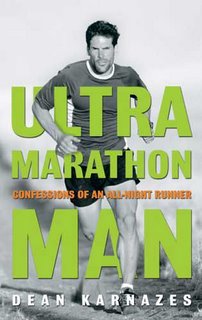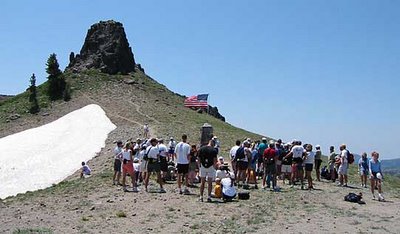Note by KC:
For those who run 10km or half marathon, what is stopping you from running a full marathon? For those who run full marathon, do you think that running 42 km is very far? Wait till you hear other runners running in ultra-marathon. Just like the Chinese saying: there is always another mountain higher than the current one.
x
After crossing the finishing line of the 10km running races organized by FTAAA, Meng would say, “Come on! Let us challenge the 21km race next time.” But I said, “I am too tired at the finishing line and I think I would not have the ability to do another 10km.” The same suggestion and reply were repeated many times. That was in 2003. Prior to that, we have been running 10km races for almost five years!

At that time, running a full marathon was something an unachievable feat to me. The distance of a full marathon is 42 km or 26 miles (1 mile is 1.6 kilometers). Today, this is history. I have run five full marathons since 2004 whereas Meng has done five in 2004; five in 2005 plus one Ultra-marathon and one 24-hour Walk at Genting. According to Meng, this is a natural progression of advancement and we should not just stop at the same level of achievement.
Compare to ultra-marathon, running a single marathon is kiddy stuff. A 100-mile ultra-marathon is equivalent to running four marathons back-to-back, amidst very tough terrain. You think running a full marathon is tough? Then read on ….
Extracted from the book Ultra-marathon Man
By Dean Karnazes
Unbelievable. It didn't seem humanly possible to run 100 miles nonstop, let alone 100 miles through the mountains. That's nearly four marathons without rest. To qualify for the Western States, you must complete a fifty-mile race in less than nine hours. Like the Boston Marathon, the Western States only accepts the elite.

The Western States 100-Mile Endurance Run didn't start as a run at all; its inception can be traced to a long distance horse race, the Tevis Cup, 100 miles through the mountains on horseback. But in 1974, a man named Gordy Ainsleigh changed everything. Gordy had trained relentlessly with his horse for a year, and, as legend has it, just prior to the event his horse came up lame.
Crushed, but undeterred, Gordy announced that he would still be competing in the 100-mile race, only without his horse.
This did more than raise a few eyebrows. It was complete lunacy. But on August 3, 1974, a bare-chested Gordy Ainsleigh took his place at the starting line of the Tevis Cup alongside a row of horses. Apparently right before the race began, one of his friends was overheard asking him whether he wanted a ham sandwich or a feed bag. Another bystander purportedly asked a race official if the event was reserved exclusively for animals. To which the official replied, "He is an animal."
Amazingly, 23 hours and 42 minutes later, out from the trailhead popped Gordy. He was somewhat incoherent and despondent, but still shuffling forward. With a will of iron, he'd covered the entire 100 miles on foot. He even managed to beat a few of the horses.
It was this astonishing accomplishment that ushered in the modern era of ultra-endurance trail running.

Endurance is a relative term. Some might think a marathon, at 26.2 miles, with its two to five hours of continuous pounding to the body, is the ultimate test of human endurance. Hills make the undertaking all the more demanding; the Boston Marathon, for example, includes the infamous “Heartbreak Hill" a climb of 280 vertical feet. That's nearly the length of a football field straight up into the air. It's the vertical equivalent of climbing one quarter of the way to the top of the Empire State Building. Heartbreak Hill can be a demoralizing obstacle that forces many runners into submission, and they walk.
For an ultra-elite group of athletes, however, a single-marathon is child's play. The challenges these individuals seek are beyond comprehension, bordering on psychotic. They participate in endeavors so physically demanding that some have perished in the act.
Near the top of the intensity scale is the Western States 100-Mile Endurance Run. It involves a total elevation change of 38,000 feet, climbing the equivalent of over fifty football fields straight up into the air. That would be like climbing the entire distance to the top of the Empire State Building and back down again—fifteen times! It means climbing and descending Heartbreak Hill not once, not twice, but fifty-six times. For a comparison of the Western States 100-Mile Endurance Run and the Boston Marathon, check out the chart below.
After crossing the finishing line of the 10km running races organized by FTAAA, Meng would say, “Come on! Let us challenge the 21km race next time.” But I said, “I am too tired at the finishing line and I think I would not have the ability to do another 10km.” The same suggestion and reply were repeated many times. That was in 2003. Prior to that, we have been running 10km races for almost five years!

At that time, running a full marathon was something an unachievable feat to me. The distance of a full marathon is 42 km or 26 miles (1 mile is 1.6 kilometers). Today, this is history. I have run five full marathons since 2004 whereas Meng has done five in 2004; five in 2005 plus one Ultra-marathon and one 24-hour Walk at Genting. According to Meng, this is a natural progression of advancement and we should not just stop at the same level of achievement.
Compare to ultra-marathon, running a single marathon is kiddy stuff. A 100-mile ultra-marathon is equivalent to running four marathons back-to-back, amidst very tough terrain. You think running a full marathon is tough? Then read on ….
Extracted from the book Ultra-marathon Man
By Dean Karnazes
Unbelievable. It didn't seem humanly possible to run 100 miles nonstop, let alone 100 miles through the mountains. That's nearly four marathons without rest. To qualify for the Western States, you must complete a fifty-mile race in less than nine hours. Like the Boston Marathon, the Western States only accepts the elite.

The Western States 100-Mile Endurance Run didn't start as a run at all; its inception can be traced to a long distance horse race, the Tevis Cup, 100 miles through the mountains on horseback. But in 1974, a man named Gordy Ainsleigh changed everything. Gordy had trained relentlessly with his horse for a year, and, as legend has it, just prior to the event his horse came up lame.
Crushed, but undeterred, Gordy announced that he would still be competing in the 100-mile race, only without his horse.
This did more than raise a few eyebrows. It was complete lunacy. But on August 3, 1974, a bare-chested Gordy Ainsleigh took his place at the starting line of the Tevis Cup alongside a row of horses. Apparently right before the race began, one of his friends was overheard asking him whether he wanted a ham sandwich or a feed bag. Another bystander purportedly asked a race official if the event was reserved exclusively for animals. To which the official replied, "He is an animal."
Amazingly, 23 hours and 42 minutes later, out from the trailhead popped Gordy. He was somewhat incoherent and despondent, but still shuffling forward. With a will of iron, he'd covered the entire 100 miles on foot. He even managed to beat a few of the horses.
It was this astonishing accomplishment that ushered in the modern era of ultra-endurance trail running.

Endurance is a relative term. Some might think a marathon, at 26.2 miles, with its two to five hours of continuous pounding to the body, is the ultimate test of human endurance. Hills make the undertaking all the more demanding; the Boston Marathon, for example, includes the infamous “Heartbreak Hill" a climb of 280 vertical feet. That's nearly the length of a football field straight up into the air. It's the vertical equivalent of climbing one quarter of the way to the top of the Empire State Building. Heartbreak Hill can be a demoralizing obstacle that forces many runners into submission, and they walk.
For an ultra-elite group of athletes, however, a single-marathon is child's play. The challenges these individuals seek are beyond comprehension, bordering on psychotic. They participate in endeavors so physically demanding that some have perished in the act.
Near the top of the intensity scale is the Western States 100-Mile Endurance Run. It involves a total elevation change of 38,000 feet, climbing the equivalent of over fifty football fields straight up into the air. That would be like climbing the entire distance to the top of the Empire State Building and back down again—fifteen times! It means climbing and descending Heartbreak Hill not once, not twice, but fifty-six times. For a comparison of the Western States 100-Mile Endurance Run and the Boston Marathon, check out the chart below.
 The Western States is run on rugged single-track mountain trails with harrowing drop-offs and unpredictable terrain. It crosses snow and ice fields, descends into murderously hot valleys, fords numerous bridgeless rivers, and offers little in the way of food, water, or medical support along the way. Of those who successfully complete the event—and sometimes fewer than half of the invited athletes do—it typically means twenty-five to thirty hours of continuous running.
The Western States is run on rugged single-track mountain trails with harrowing drop-offs and unpredictable terrain. It crosses snow and ice fields, descends into murderously hot valleys, fords numerous bridgeless rivers, and offers little in the way of food, water, or medical support along the way. Of those who successfully complete the event—and sometimes fewer than half of the invited athletes do—it typically means twenty-five to thirty hours of continuous running.Outside magazine once called the Western States the "toughest endurance event in the world." To complete it, your mental resolve must be indomitable. You've got to bundle up self-doubt and fear and stuff them in your shoe, cutting loose your rational mind as your body is pushed to inconceivable levels of endurance. To complete the Western States, you must transform yourself into a human machine.
x
No comments:
Post a Comment